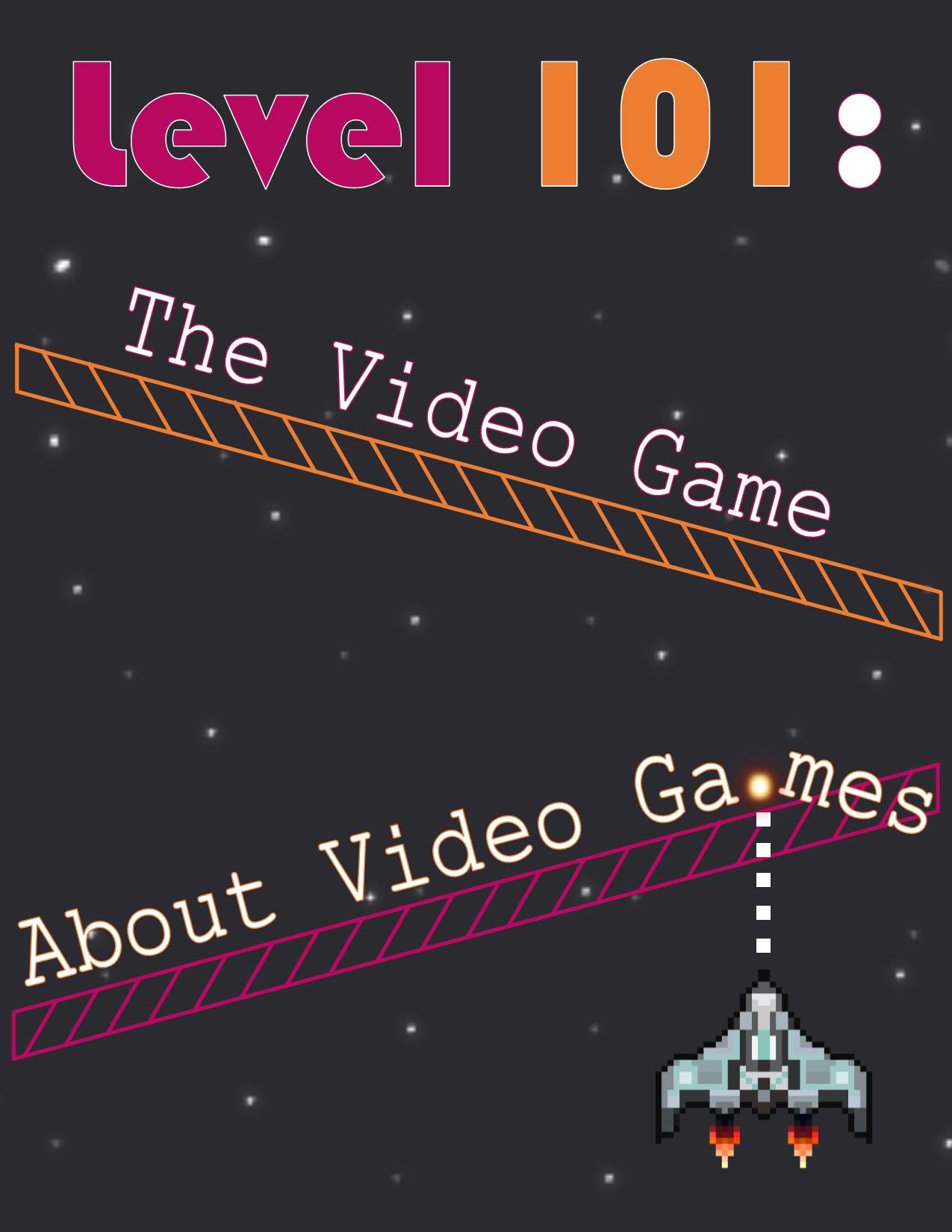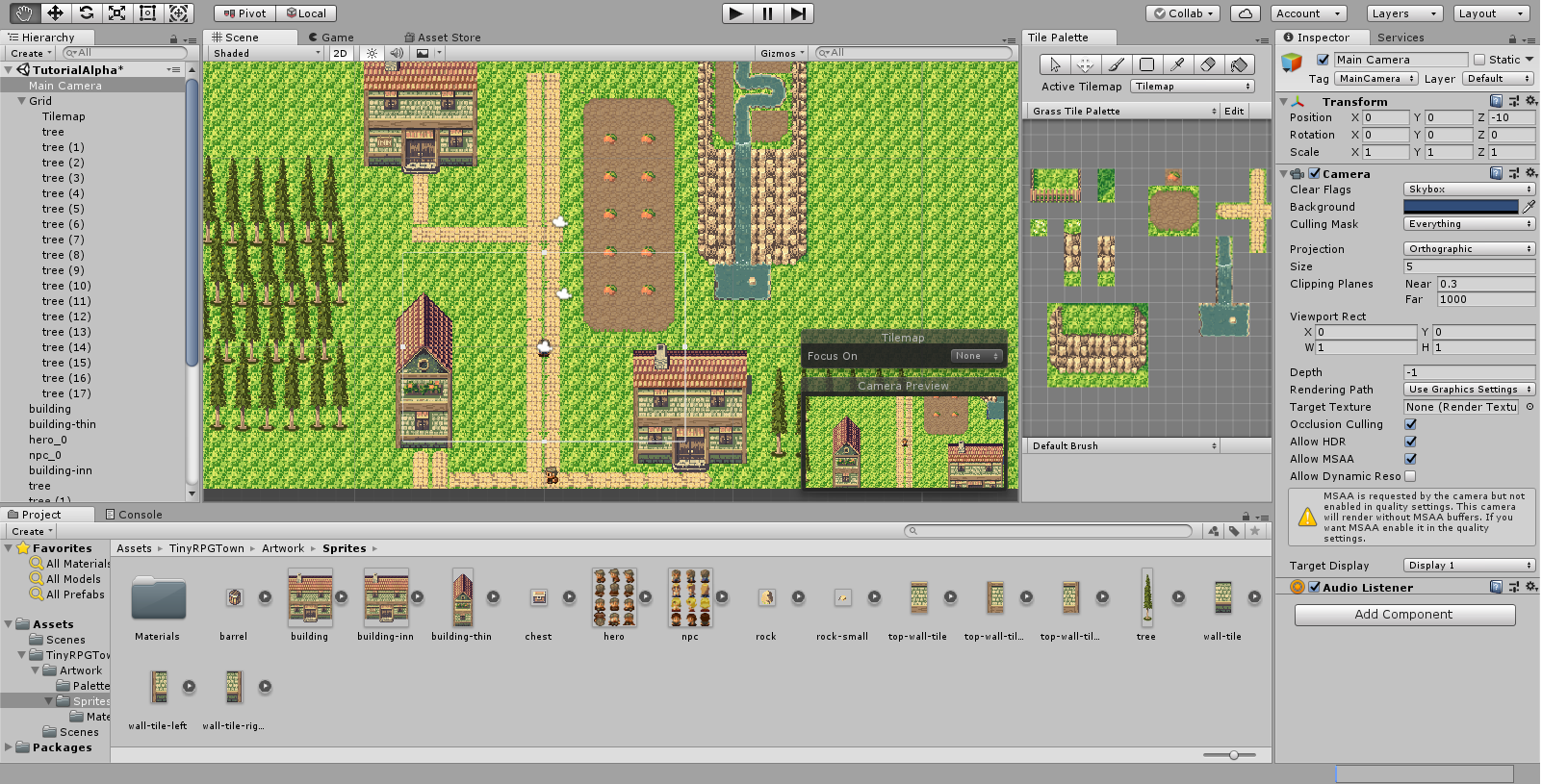Level 101: A Video Game About Video Games – Interdepartmental Collaboration, Tutorials, and Pre-Production
Summer 2018 Seed Grant Funding Report
Report submitted by Justin Wigard and Beth LaPensée
Project Overview
We applied for the DH Summer Seed Grant to further the development of Level 101, a video game developed with the program Unity that addresses a pedagogical gap in higher education. This grant was to go towards three components of research and development in order to further the development of Level 101: 1) Unity development assets, 2) video games created with Unity, and 3) research texts associated with game studies, game development, and digital humanities.
Currently, the methods of understanding and analyzing video games are taught through a variety of formats (traditional text publications, video critiques, audio podcasts, etc.), but there is one avenue that is curiously absent: playable criticism.
 Level 101: A Video Game About Video Games is a serious video game that hopes to address this gap in pedagogy by explaining, interrogating, and deconstructing the video game medium through three significant branches of understanding video games: 1) Video game history, 2) Video game design, and 3) Video game genre. Each of these three branches features five levels that are designed to educate players about the video game as a medium, as well as encourage players to think critically about video games and the process of playing through them. The primary audiences are twofold: college instructors who will use and assign the video game as a lecture supplement, and college students who would play through the video game.
Level 101: A Video Game About Video Games is a serious video game that hopes to address this gap in pedagogy by explaining, interrogating, and deconstructing the video game medium through three significant branches of understanding video games: 1) Video game history, 2) Video game design, and 3) Video game genre. Each of these three branches features five levels that are designed to educate players about the video game as a medium, as well as encourage players to think critically about video games and the process of playing through them. The primary audiences are twofold: college instructors who will use and assign the video game as a lecture supplement, and college students who would play through the video game.
As a result of the DH Summer Seed Grant, the project’s development process has evolved to include interdepartmental collaboration with the MSU Library, an informal user experience study aimed at gathering data on video game tutorials, and the pre-production of Level 101. Ultimately, a playable alpha-demo of Level 101 is expected to be unveiled at the DH Locus-Symposium in December 2018.
Previous Progress on Level 101
Prior to receiving the DH Summer Seed Grant, Wigard began this project during a summer 2017 course with Dr. LaPensée, MI 491 in the form of a 2-minute playable demo, which was developed further in coursework such as MI 831 (also with Dr. LaPensée) and MI 830 (with Dr. Carrie Heeter) as part of the Graduate Serious Games Certificate, as well as in DH 865 with Dr. Kathleen Fitzpatrick as part of the Digital Humanities Graduate Certificate.
Over the course of the last year, Wigard created two separate stages of the video game as proof of concept.
One is a stage aimed at teaching players the history of early video games through a playable demo of a text-based adventure game. 
The other is a stage intended to provide players with experience engaging with the platformer genre in order to understand and critique other platforms like Super Mario Bros. 
Development #1: Working with the MSU Library
However, we worked in conjunction with the MSU Library to acquire several video games created with Unity and several of the texts related to the study. This collaboration with the MSU Library meant that the texts and games would be available to us throughout the growth of this project, but still be able to be circulated to the MSU community as a whole once the project was completed. Through the collaborative efforts of several MSU librarians, including Jonah Magar and Ranti Junus, as well as the efforts of Kristen Mapes, Assistant Director of Digital Humanities at MSU, the MSU Library was able to purchase six video games for the Library’s Video Gaming Lab, as well as four books for overall library circulation. These include:
- Books
- The Video Game Theory Reader 2, edited by Bernard Perron and Mark J.P. Wolf
- Blood, Sweat, and Pixels: The Triumphant, Turbulent Stories Behind How Video Games Are Made by Jason Schreier
- Game On! Video Game History from Pong and Pac-Man to Mario, Minecraft, and More by Dustin Hansen
- Cybertext: Perspectives on Ergodic Literature by Espen J. Aarseth
- Video Games
- Gone Home
- Firewatch
- Ori and the Blind Forest
- Inside
- Limbo
- Subnautica (expected: December)
In particular, Game On! By Dustin Hansen and The Video Game Theory Reader 2 have been instrumental in the design of future stages, as Game On! provides a historical foundation for one primary track of gameplay in Level 101, the History module, and The Video Game Theory Reader 2 informs the Genre module of Level 101.
Development #2: Pre-Production on Level 101
Upon receiving the DH Summer Seed Grant, pre-production began on the game as a whole, and specifically, at the beginning of the game: the tutorial stage. At this stage of production, we felt that it would be beneficial to gain more insight into what elements of a video game tutorial are most effective, before we proceed with developing our own tutorial.
An informal user experience study was conducted (in conjunction with MI 841, taught by Dr. Carrie Heeter) to collect information and data about the user experiences of instructors playing through a video game tutorial of an existing video game, Pokemon FireRed. This study featured two phases: one observational task analysis study, and one 10-question interview conducted after the study. Each session was expected to take 20 minutes total.
While we are still processing a lot of the data which will inform the design and development of the tutorial sequence, some highlights that came out of the study were recommendations to:
- Provide information on why players are making choices, and what impact that might have on their future gameplay (Task Analysis, Interview)
- Level 101: Provide insight/feedback on what branch of the game might be easier for newer players, or which is suggested to begin with to help frame the rest of their playthrough.
- Make early objectives easy to see or find (Task Analysis)
- Level 101: Players should know what they are looking for (visually or narratively), and players should know how to proceed further.
- Perhaps there could be a function to reveal a glowing blue or yellow arrow to indicate what direction players should head if they feel lost.
- Use a combination of direct, indirect, and supplemental instruction (Interview)
- Level 101:
- Direct instruction: implement a button tutorial.
- Direct instruction: refine Professor’s lectures
- Indirect: Implement NPCs that provide helpful information.
- Supplemental instruction: refine helpful signs already present
- Have the tutorial be woven into the story, and vice versa (Interview)
- Level 101: Reinforce the narrative that they are a learner of video games, be they student, instructor, developer, or somebody outside that trifecta.
- Implement a skip function for experienced video game players (interview)
- Level 101: Because this is a pedagogical game, this may be best implemented in terms of a questionnaire:
- Ask questions about whether they feel comfortable skipping mechanics
- Perhaps implement a “Quiz” level, where players can skip the tutorial if they pass a series of questions about the mechanics of the game.
- Perhaps implement a “Tutorial Challenge,” where players can skip the tutorial if they pass a gameplay challenge.
- Consider a follow-up study or survey about skipping tutorials.
- Ask questions about whether they feel comfortable skipping mechanics
- Implement a 5-10 minute tutorial, one that begins with direct instruction before slowly introducing new mechanics or new elements to the game.
- Level 101: Explain the buttons, explain the core mechanics and purpose, then introduce the game world itself.
- Level 101: Because this is a pedagogical game, this may be best implemented in terms of a questionnaire:
- Level 101:
- Level 101: Players should know what they are looking for (visually or narratively), and players should know how to proceed further.
With this in mind, we have begun developing the tutorial level using Unity. Because this level is in the Alpha stage of development, we have started with a premade set of visual assets, “TinyRPGTown,” which will allow us to construct our main scene using freely available assets. Once we have proceeded further into our development, we will be purchasing specific visual assets and audio assets to fit the level we design.
We have begun implementing the informal recommendations gleaned from our user experience study by focusing on creating a 5-10 minute tutorial that is woven into the story. Our intention is to create a tutorial that positions the player as a hero-figure on a quest to gain knowledge about the world around them. Each level thereafter represents another stepping-stone in the quest for knowledge, levelling up by proceeding through more lessons. In addition, we are working to make early objectives easy to find, so there will only be a few paths and a few objects to interact with in the tutorial.
Looking Ahead
We plan to use the rest of our DH Summer Seed funding to purchase audio and visual assets for our tutorial stage, as well as common assets that can be used across the rest of the levels. In particular, we are considering several Graphical User Interface assets that can be more or less universal across the different planned levels
As our development process took longer than expected to gain traction, we hope to present a playable demo of Level 101’s tutorial at the December Locus mini-symposium here at MSU. Because the existing Beta-stage levels were developed with other programs (Twine and Construct 2), we hope to translate or recreate these beta stages within Unity in order to present a more complete demo of Level 101. Once we have presented our work at the December Locus, we plan to update this post or append it with an update to include a link to the playable demo of Level 101.
